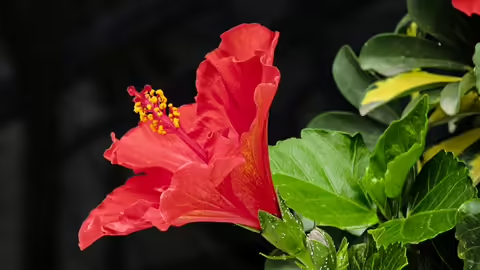URBANA, Ill. – Tropical plants have gained a lot of popularity in recent years as an easy way to add an attractive look to back patios, decks, and containers. Plants such as mandevilla, alocasia (elephant ear), and hibiscus are sold at garden centers in containers and, while they offer great interest over the warm months, by the first hard frost they are done for.
“In essence, tropical plants are treated as annuals in the landscape, but with a few tricks and some practice, these unique tropical plants can be overwintered and revived for the next year,” saysAustin Little, University of Illinois Extension horticulture educator.
With regard to overwintering, there are three categories of tropical plants: 1) plants that produce big tuberous roots like alocasia (elephants ear) or cannas; 2) tropicals that produce woody stems with fleshy crowns and fibrous roots, such as mandevilla; and 3) soft-stemmed tropicals with fibrous roots, like begonia or coleus.
For overwintering tropicals with bulbs or fleshy tubers, wait until the foliage starts to die back after the first light frost, and then lift them out of the soil with a gardening fork. Trim the leaves down to an inch or so, and let the bulbs dry out for a few days in a shaded area out of the rain. Once they have dried, brush off any extra soil, and they’re ready for storage. A breathable cardboard box is good, but they can also be stored in an open tote or crate. Store the bulbs in dry peat, wood shavings, or wrap them in newspaper. Keep the box in a cool, dark place such as a cellar or garage that does not get much above 55 or below 32 degrees Fahrenheit. Bulbs can be repotted and started a few months before the last frost or they can be planted outside when soils warm above 65 degrees.
Tropicals like mandevilla and lantana are woody shrubs in their native range but can be tricked into dormancy for the winter. Following the first frost, cut back the foliage to about six inches, transfer the root balls to containers, and store them in a cool, dark spot next to your alocasia. Water lightly over the winter, every few weeks at most. A month or so before the last frost, they can be moved into the light and given more water. After the last frost, they can be moved outside to harden off and may benefit from a light application of tropical fertilizer.
Soft, fleshy-stemmed tropical plants are best overwintered by taking vegetative cuttings and letting them root in a well-drained potting mix in the sunniest location in the house. The plants will not need much water over the winter; rather, it is better for the soil to be on the dry side. Ensure the foliage does not contact glass windows, as this can cause freeze damage.
News source/writer: Austin Little, 618-687-1727, little84@illinois.edu
